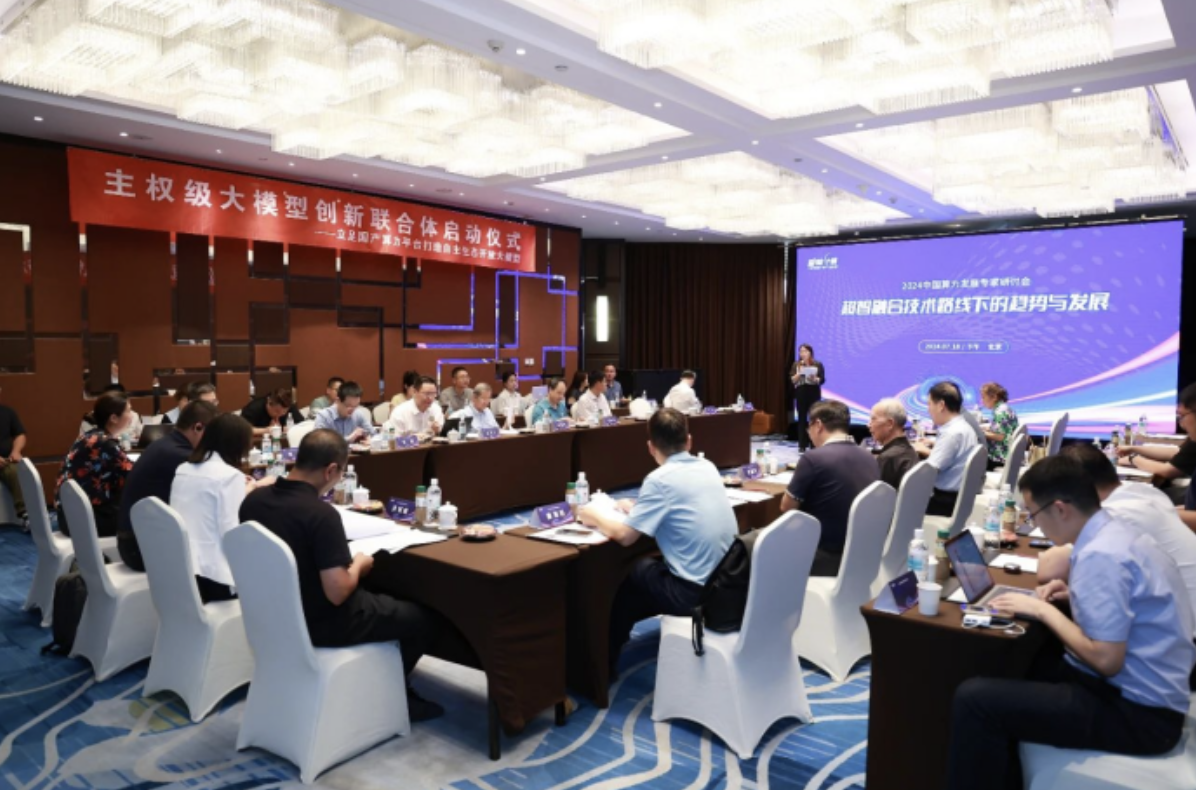
股票代码:833352
中文|



The Third Plenary Session of the 20th CPC Central Committee deliberated and adopted the Decision of the CPC Central Committee on Further Comprehensively Deepening Reform and Promoting Chinese-style Modernization, which proposed to improve the system and mechanism for developing new quality productive forces in light of local conditions, and foster new industries, new models and new drivers of growth. We will deepen reform of the management system for science and technology, strengthen the building of national strategic scientific and technological forces, leverage the leading role of China's ultra-large market, strengthen the coordination of innovation resources and the organization of innovation forces, and promote the integrated development of scientific and technological innovation and industrial innovation.
At present, the rapid integration of high performance computing (HPC) and artificial intelligence (AI) is becoming the key word of computing technology innovation. In order to grasp the trend and development direction of the super-intelligent integration technology route, and deeply explore the formation mechanism of new quality productivity driven by computing power development, the 2024 China Computing Power Development Expert Seminar co-sponsored by China Intelligent Computing Industry Alliance and the National Beacon Computing Standard Working Group was held in Beijing on July 18, and many top academicians and experts of the computing industry chain gathered together. We will launch the establishment of a sovereign large-model innovation consortium to jointly explore a new path for the development of super-intelligent fusion technology.
Superintelligence fusion technology deeply integrates supercomputing power with intelligent algorithms, realizes efficient processing and deep mining of massive data, and provides strong support for solving complex scientific problems and promoting industrial upgrading and innovation. In line with this trend, the national supercomputer Internet was launched in April this year, marking China's exploratory steps in the field of superintelligence integration.
In May this year, at the International Supercomputing Conference (ISC2024) held in Hamburg, Germany, the focus was on reshaping the topic of supercomputing and the new trend of super-intelligence integration, which has also aroused wide attention from all walks of life.
"Superintelligent fusion will usher in a blowout explosion in the next 4-5 years. Taking this as an opportunity, it can promote the collaborative innovation of computing chips, applications, machines and systems, and accelerate the development of computing technology." He Tiening, executive deputy director of the National High Performance Computer Engineering Technology Research Center, said at the time that the super-intelligent fusion is a milestone in the evolution of computing technology, marking the transition from general computing to traditional scientific computing, to a new era of heterogeneous accelerated AI computing. The two technologies complement each other and will redefine the field of computing.
At the seminar, Zhang Yunquan, a researcher at the Institute of Computing Technology of the Chinese Academy of Sciences, pointed out in clarifying the research background that the rapid development of large models highlights the characteristics of new quality productivity, but also highlights the bottleneck of computing power. In view of China's deep technology accumulation in the field of supercomputing, the industry this year focused on supercomputing integration, aiming to respond to the computing power needs of large models in a timely manner, and maximize the use of supercomputing technology advantages to solve the current challenges.
The experts agreed that under the background of Moore's Law approaching the physical limit and the burden of a single computing architecture, superintelligent fusion is an inevitable trend in the evolution of computing technology in the future. The real realization of superintelligent fusion needs to follow the principle of gradual and organic integration.
"Super-intelligent integration is the trend of The Times, but it is necessary to seek breakthroughs at the basic theoretical level and achieve deep organic integration in order to maximize performance and efficiency." Chen Runsheng, an academician of the Chinese Academy of Sciences.
Qian Depei, academician of the Chinese Academy of Sciences and leader of the supercomputer Internet Overall expert group, further proposed the development path of superintelligence integration. He believes that the process of superintelligence integration can be promoted along the three levels of supercomputing to support AI applications (for AI), using AI technology to improve supercomputing (by AI), and super intelligence to achieve endogenous integration (being AI), and evolve from hardware to software in an all-round way to adapt to and promote the development of artificial intelligence technology.
"In the development process of super-intelligent fusion technology, application drive has become a key driving force for technological evolution." Shan Zhiguang, director of the information and Industrial Development Department of the State Information Center, pointed out that the emergence of superintelligence integration first stems from the urgent need for the transformation of the current application side of computing power structure, and the integration of multiple computing power can build a new computing ecosystem that is more adaptable to the needs of the AI era.
Yuan Guoxing, a researcher at the Institute of Applied Physics and Computational Mathematics in Beijing, also believes that different applications need different algorithms and have different requirements for computers, and the fundamental value of super-intelligent integration is to be closely combined with practical applications to solve the pain points of the industry.
Occupy the highlands in a sovereign scale model
Semiconductor process restrictions, complex and changing international situation, insufficient supply of AI chips, lack of computing support for algorithms and data, lack of unified planning for AI chip companies, lack of investment and construction in the ecology and market... At the seminar, the experts said that a series of problems to be solved have become the main challenges for China to cope with the development of large model industry. As the next generation of artificial intelligence blue ocean rushes to the new heights of the large model that the science and technology of various countries compete to seize, it is urgent to solve the relevant problems.
How to solve it? At the seminar, the sovereign level large model innovation consortium was launched. Quiet, secretary general of China Intelligent Computing Industry Alliance, introduced that as an effective means to achieve new quality productivity, the original intention of developing sovereign level basic large model is to directly solve the computing power and intelligence challenges faced by the development of general AGI in our country.
At the National Two Sessions in 2024, Zhang Yunquan, a member of the National Committee of the Chinese People's Political Consultative Conference, proposed for the first time to build a "sovereign level basic model", calling on the country to lead the integration of high-quality scientific research and industrial strength, and train China's "sovereign level large model" as soon as possible to enhance national competitiveness and maintain future national security.
Zhang Yunquan explained that the "sovereign level large model" is a dynamic concept, referring to the highest level of the basic large model in a certain period of time, its highest level of general intelligence, the highest requirements for computing power, is the embodiment of a national AI level. At the same time, the technical level of the basic large model also profoundly affects the intelligence level of the application of large model technology in the industry.
Zheng Weimin, academician of the Chinese Academy of Engineering and professor of the Department of Computer Science at Tsinghua University, stressed that at this stage, it is not only necessary to make full use of the resources of the national supercomputing center to support large model training and optimization, but also to focus on the domestic AI accelerator card. Develop programming framework, parallel acceleration, communication library, operator library, AI compiler, programming language, scheduler, memory allocation, fault tolerant system, storage system ten key software, and constantly improve the level of independent ecological development.
"Superintelligent integration in practice is gradually showing its value, technological innovation, environmental changes and market demand changes to promote this integration trend, almost every supercomputing center is integrating intelligent computing chips, the future may have a 'superintelligent computing center'." Deng Lianbing, director of the Guangdong-Macao Advanced Intelligent Computing Joint Laboratory, analyzed the significance of the sovereign-level large model from two aspects: at the technical level, the "super intelligence center" needs to solve the problem of technology integration, not only to meet the deep integration needs of intelligent computing and AI algorithms, but also to break the "island effect" formed by the technology system of different manufacturers. The application of the sovereign grand model will promote cooperation among all parties and jointly build and share an open platform. At the level of operation and maintenance, the state guidance or market mechanism can be used to build an ecology around the sovereign level large model, which can solve the contradiction between the low utilization rate of the computing power center and the difficult to meet the computing power needs of small and medium-sized enterprises.
"The national supercomputing platform is an ideal choice to build a sovereign scale model." Qian Cheng, vice president of the Guangdong Intelligent Research Institute, said that in the future, the "root model" created based on the national supercomputing platform enables the supercomputing centers of more than a dozen countries, and then enables more computing centers, and finally lands on the specific application scenarios, which can form a complete ecosystem of sovereign large-scale models.

(Source: China High-tech Industry Guide)




